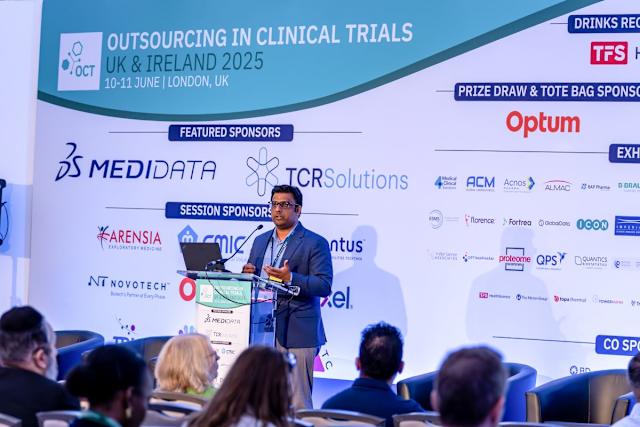Adapting to funding and operational hurdles in today’s clinical trials landscape

Against the backdrop of geopolitical tensions and economic measures such as tariffs, which are influencing supply chains across numerous industries, biotech companies are facing significant capital constraints, which in turn affect clinical trial activity.
At the 12th Annual Outsourcing in Clinical Trials (OCT) UK and Ireland, which took place in June in London, UK, industry leaders delivered comprehensive insights and examined current market trends in today’s clinical trials landscape both in the UK and on a global level.
At the meeting, Aditya Kotta, head of business development of US and EU at global contract research organisation (CRO) Novotech, said investors are placing greater emphasis on later-stage data to overcome funding challenges.
He said that in the case of early-stage assets, companies are now prioritising proof-of-concept data and streamlining their focus to achieve that swiftly and efficiently. In some cases, companies may concentrate resources on a single lead asset to maximise the likelihood of generating compelling data.
Attractive ex-US locations for early-phase trials
Over the past several months, particularly in the last two quarters, Kotta has observed a noticeable shift among biotech companies that are pushing towards “ex-US” strategies in clinical development, namely a switch towards regions such as Australia, Asia-Pacific, Eastern Europe, and even China for early-phase clinical trials.
Such a trend reflects a growing strategic interest in diversifying trial geography to capitalise on the advantages offered by these regions, Kotta noted.
According to Kotta, Australia has emerged as a leading location for early-phase trials due to a favourable regulatory environment, reduced costs, and high-quality data output. Countries such as Australia and New Zealand are also experiencing a lower rate of decline in clinical trial activity compared to the US.
An analysis of clinical trial registries, including ClinicalTrials.gov and Australian and New Zealand registries, showed a significant and notable decline in clinical trial activity, approximately 20% year over year, when comparing H1 2024 to H1 2025.
“Oncology trials typically make up about 30% to 40% of the market share of total clinical trials,” Kotta said. But between H1 2024 and H1 2025, there was an approximately 60% drop in oncology trial activity.
Although nearly all therapeutic areas have seen reductions in clinical activity, some have demonstrated relatively strong resilience. Trials focused on obesity and RNA-based therapeutics continue to show robust performance and retain investor interest.
繼續閱讀Challenges with non-enrolling sites
Another key theme that was discussed at length at OCT UK & Ireland was the issue of patient and site engagement.
The issue of non-enrolling clinical sites is not new and remains a consistent challenge across the industry, according to Esther Kitto, vice president of clinical operations at Resolution Therapeutics, which is developing a regenerative macrophage therapy for patients with end-stage liver disease.
She acknowledged that Resolution’s recruitment model, where patients are referred or follow a natural treatment pathway, has remained largely unchanged over the last two decades. However, the UK-based biotech is making strides to widen outreach and participation, expand the patient pool, increase recruitment rates, and reduce the number of inactive sites to address enrollment inefficiencies.
Also advocating for revising old models of trial recruitment and management was TRI CEO Duncan Hall. The risk-based quality management (RBQM) employed by TRI analyses trial data to identify risks to trial success early, and allows coordinators to respond accordingly, replacing prior labour-intensive systems, as Hall told Clinical Trials Arena.
“RBQM adoption is on the rise…but the benefits from RBQM are not being fully realised,” Hall stated.
He said TRI is now looking to incorporate AI techniques into its methodology, but human interaction will always be core to trial monitoring, with the patient-investigator relationship remaining key.
Moving towards closer patient engagement
Kitto said that recent findings show that nearly 30% of patients drop out of trials, not due to adverse events or safety concerns, but due to fatigue or lack of motivation. She added that patient retention is crucial, not just for ethical reasons, but also for maintaining data integrity.
Patient advocates are keen to build closer ties with trial coordinators and industry, said Richard Stephens, a patient advocate from the Cancer Research Advocates Forum (CRAF-UK). He added that from patients to drug developers, it is in the interests of all parties involved to see timely and successful trial enrollment to support both the scientific goals of trials and the hopes held by participants for innovative cures and improved overall care.
Stephens also called for closer collaboration between patient advocacy groups, especially across national boundaries, to facilitate greater enrollment through international trials.
Kitto said that such collaborations go beyond simply sharing patient-facing documents such as information sheets and brochures. Resolution now shares full protocols with advocacy groups, enabling them to provide input on trial design aspects, including the number of interventions and procedures, as well as overall patient burden. She also stated that this inclusive approach aims to ensure that trials are more aligned with patient needs and experiences, promoting both transparency and engagement.
Nonetheless, certain approaches to engaging with patients require greater forethought. The potential use of AI to enhance patient engagement was discussed in the second day’s keynote address by Blanka Hezelova, associate director at GSK. In particular, Hezelova noted that trial forms used to establish informed patient consent are often viewed as complex, impersonal, and unclear with regard to data privacy.
Hezelova stated that with the advent of advanced AI, consent forms can be personalised to individual participants, expressed in plain language, and driven by data. However, she warned: “AI, unfortunately, does have a very serious risk of becoming coercive and manipulative,” and highlighted concerns around AI hallucinations and bias.
Hezelova, therefore, stressed the continued need to train human trial coordinators and clinicians to offer in-person guidance as central to ensuring the trust of participants, key to addressing enrollment challenges. As regulatory bodies lag behind the pace of AI progress, she said developers and CROs must prepare for a transition period of clinical AI characterised by “transformation, long-term changes”.
The UK’s clinical trial challenges and initiatives
In regard to clinical trial challenges specific to the UK, Kitto noted that the decentralised nature of the National Health Service (NHS) complicates trial setup timelines. Kitto proposed having centralised coordination within each hospital or NHS trust and a dedicated individual overseeing all clinical trial setup logistics, which could streamline these processes.
Further challenge comes from limits on NHS staff capacity to engage in clinical trials. The research workforce is a major bottleneck to NHS-led trials, according to Karolin Kroese, programme office lead at the Experimental Cancer Medicine Centre Network.
The issue is compounded by a fundamental lack of career growth opportunities, said Dr Davy Yeung, COO at British CRO TCR Solutions.
“There is no career pathway for research nurses,” he stated, with many seeking advancement through other careers such as academia.
However, recent changes to the UK Medicines and Healthcare products Regulatory Agency (MHRA’s) Innovative Licensing and Access Pathway (ILAP) can be expected to accelerate patient access to new medicines through improved collaboration between national healthcare systems and drug developers, as per Dr Austin Smith, CMO of Sweden-based Oxcia.
Expected updates to the 2004 Medicines for Human Use (Clinical Trials) Regulations to facilitate medicine manufacture near points of patient care were cause for optimism, according to Shasheen Payoe, PhD, clinical account manager at Germany-based Miltenyi Biotec.
With new clinical trial regulations on the horizon, there is an opportunity to move the industry forward, said Sarah Deely, director of country and site operations at Biogen.
UK industry and healthcare innovating through collaboration
Biogen is proactively engaging with key regulatory and policy stakeholders, including the MHRA, National Institute for Health and Care Research (NIHR), and the Association of the British Pharmaceutical Industry (ABPI), not just as participants, but as collaborators in shaping these regulations.
Deely added that Biogen is also deeply involved in the rollout of the Clinical Research Delivery Centres (CRDCs)—regional hubs established across the UK to facilitate and accelerate research. She stated that the company, which is conducting trials in rare diseases, co-develops its protocols with global and UK-based medical experts to reduce the burden on both patients and sites. Deely added that the aim is to avoid unnecessary amendments later and to align protocols with UK healthcare realities, including post-approval reimbursement and long-term care needs.
Additionally, some UK hospitals have embedded patient and public involvement (PPI) teams to link sponsors, medical experts, and patients to ensure operational efficiency and patient-centricity.
The UK’s NHS should be more fundamentally centred around clinical trials through collaboration with industry to foster greater innovation in the country’s pharmaceutical sector, said Stephens.
Though he recognised the strain on resources experienced by many hospitals, Stephens remained convinced the UK could shore up its clinical trials sector.
"Adapting to funding and operational hurdles in today’s clinical trials landscape" was originally created and published by Clinical Trials Arena, a GlobalData owned brand.
The information on this site has been included in good faith for general informational purposes only. It is not intended to amount to advice on which you should rely, and we give no representation, warranty or guarantee, whether express or implied as to its accuracy or completeness. You must obtain professional or specialist advice before taking, or refraining from, any action on the basis of the content on our site.













